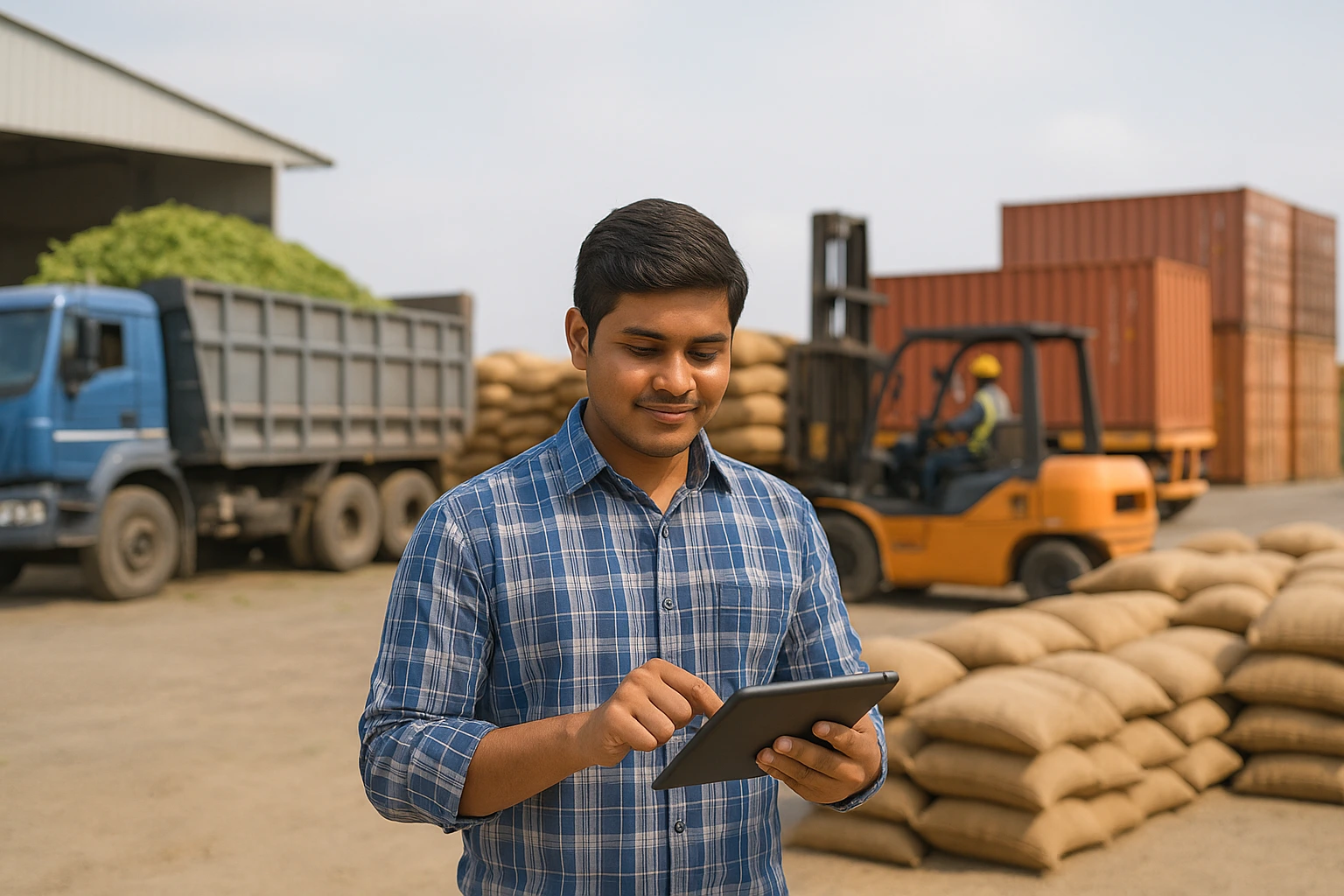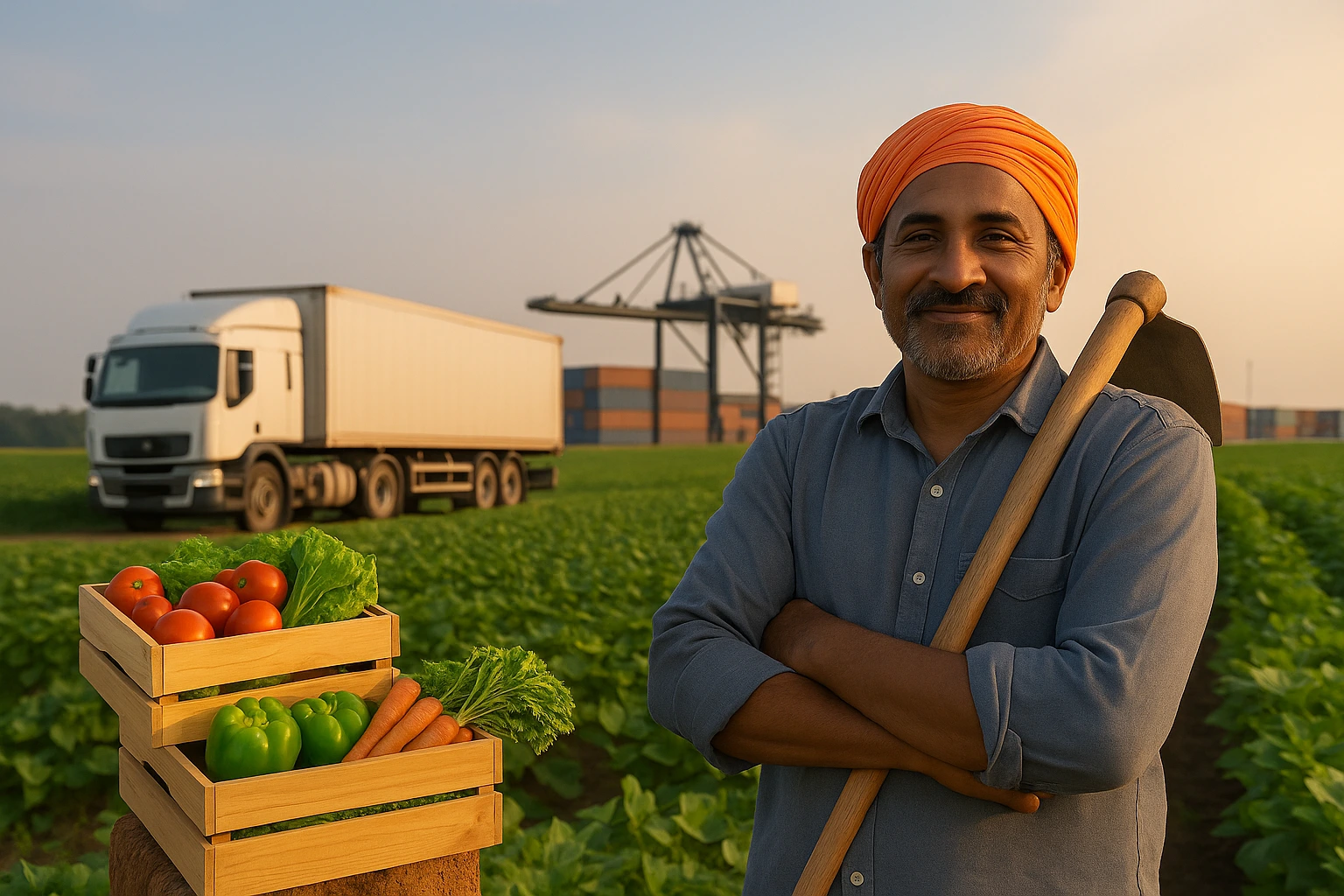In today’s fast-changing food economy, the journey from farm to table is no longer simple. Farmers grow high-quality produce, but getting it safely and quickly to distant urban markets — or even across borders — can be a major challenge.
This is where logistics partnerships make a real difference. By working with experienced logistics providers and using modern agri-logistics solutions, farmers can connect directly with urban and global markets, reduce post-harvest waste, and secure better prices for their produce.
The Significance of Effective Logistics in Agriculture
For farmers, good logistics are as important as good soils. Logistics is composed of everything from transport and storage, to packing and delivery. Even the best grown produce can spoil before the customer receives it without an efficient logistics network.
In India, post-harvest losses due to poor logistics and lack of storage are estimated to cost billions, annually. When crops are delayed or not stored optimally, freshness and value are lost. If logistics are efficient, produce can get to market quickly, allowing farmers to maintain high quality and trust with the customer.
What Are Logistics Partnerships?
Logistics partnerships are relationships between farmers (or cooperatives) and organizations that manage logistics in terms of movement, storage, and sale of farm produce. Farmers can then focus on crop production and rely on the experts to handle the delivery side of business.
A few of the more commonly seen logistics partnerships in agriculture include:
- Third-Party Logistics (3PL) Providers: Organizations that store, pack, and ship for farmers.
- Farmer Cooperatives: Groups of farmers who share transportation and storage.
- Public-Private Partnerships (PPPs): Partnerships between private companies and the government to enhance the logistics in rural areas.
- Tech Startups: Platforms that connect farmers and transporters and urban buyers.
These partnerships lower transport costs and cut losses.
Connecting Farmers to Urban Markets
Urban centers are in need of fresh and local food. Yet small producers usually do not have the capacity to get their fresh food products to grocery retailers, restaurants, and online grocery markets in large cities. Logistics partnerships exist to fill this gap.
Here’s how:
- Cold chain systems keep food fresh while traveling long distances.
- Warehousing and distribution facilities optimize supply processes, establishing systems to ensure the food is delivered to grocery retailers on time.
- Last-mile delivery networks deliver food products to urban grocery retailers or directly to homes.
- Digital marketplaces allow farmers to accept direct food orders from urban areas.
For instance, StarAgri partners with farmers and agri-businesses to provide integrated logistics services such as warehousing, commodity handling and quality testing for small farmers to minimize their spoilage, and efficiently sell their products directly to buyers in larger urban cities.
Expanding Access to Global Markets
With a capable logistics partner, farmers can go global. Exporting farm products requires expertise in packaging standards, refrigerated storage, customs procedures, and international shipping routes. This can all be confusing for most farmers, but an experienced logistics partner can help simplify this task.
By partnering with experts such as StarAgri, farmers will:
- Have access to international freight and export logistics support.
- Have support in complying with global food safety and certification standards.
- Utilize sophisticated tracking systems in which the shipment can be tracked, even in real time.
These types of partnerships help Indian farmers sell product to markets in Asia, Europe and the Middle East, providing increased income and rural development.
The Role of Technology in Modern Agricultural Logistics

Technology is a powerful enabler for logistics in agriculture. When crops leave the field, right to their end point, technology provides digital tools to enhance efficiency at each step in the process.
Examples include:
- IoT sensors and GPS tracking to monitor conditions such as temperature, humidity, and location.
- Blockchain technology provides a platform for transparency and traceability along the supply chain.
- Mobile applications connecting farmers to buyers, truck operators, and warehouses in real-time.
This suite of advanced digital solutions is moving the needle toward efficiency in the coordination of agricultural logistics, providing quality control, safe storage, and transportation of goods. Improved visibility along the supply chain provides farmers with informed decisions to sell their crop at the most ideal time and to the right buyer.
Benefits of Logistics Partnerships for Farmers
Logistics partnerships offer multiple advantages beyond transport. They bring stability, trust, and long-term growth opportunities. Here’s how farmers benefit:
- Reduced costs: Shared transportation and storage lowers costs.
- Expanded priority market access: Farmers can sell into cities, supermarkets, and export buyers.
- Improved income: Better market access results in higher income and more predictable revenues.
- Better quality preservation: If handled and stored correctly, crop quality should be preserved.
- Environmental sustainability: The more efficient land use and logistics partnership will reduce food waste and environmental degradation.
Challenges and Solutions
Despite advances, we still have numerous problems that inhibit the broader viability of a better agriculture logistics ecosystem.
Infrastructure Issues: In many rural areas, there are poor roads and cold chain capabilities.
Lack of Information: Some farmers do not have experience with logistics systems or digital platforms.
Funding issues: Cold chains and warehousing require investments.
However, there are potential solutions available:
Government programs and subsidization for rural logistics help address service gaps.
Training and education programs are intended to support farmers in adopting new technologies.
Public-private partnerships, such as StarAgri’s joint ventures, assemble investment and expertise to develop long term solutions.
The Future of Agri-Logistics: Building a Resilient Food Supply Chain
The future of farming relies on innovation, sustainability, and collaboration. Immediate, transformative technologies such as AI-enabled route planning, predictive demand forecasting, and green logistics have completely altered the way food moves from farm to fork. The increased use of online grocery and meal services, demand for exports in a variety of markets, and consumers’ greater awareness all indicate that logistics will remain a key growth engine for Indian agriculture in the future. StarAgri is at the forefront of this transformation by leveraging technology, infrastructure, and partnerships with farmers to create a clear, productive agri-logistics ecosystem that benefits farmers and consumers alike.
Conclusion
Efficient logistics are the invisible engine powering modern agriculture. Through strong logistics partnerships, farmers can overcome barriers of distance, infrastructure, and perishability — and reach urban and global buyers like never before.
As a trusted agritech solutions provider, StarAgri continues to empower farmers with world-class logistics, warehousing, and market linkages. By connecting rural India to cities and the world, StarAgri is helping build a stronger, more sustainable food supply chain — where everyone, from farmer to consumer, benefits.
FAQ’s
1. What are logistics partnerships in agriculture?
They are collaborations between farmers and companies that handle storage, transport, and sale of produce, helping farmers reach bigger markets efficiently.
2. Why are logistics important for farmers?
Good logistics ensure that crops are delivered fresh, reduce post-harvest losses, and help farmers earn better prices.
3. How do logistics partnerships help small farmers?
They allow small farmers to share transport and storage facilities, lower costs, and connect directly with urban and global buyers.
4. How does technology improve agricultural logistics?
Tools like mobile apps, GPS tracking, and sensors make it easier to monitor storage, manage deliveries, and maintain product quality.
5. How does StarAgri support farmers in logistics?
StarAgri helps farmers with warehousing, transportation, and quality testing, ensuring their produce reaches urban and global markets efficiently.
Disclaimer
The content published on this blog is provided solely for informational and educational purposes and is not intended as professional or legal advice. While we strive to ensure the accuracy and reliability of the information presented, StarAgri make no representations or warranties of any kind, express or implied, about the completeness, accuracy, suitability, or availability with respect to the blog content or the information, products, services, or related graphics contained in the blog for any purpose. Any reliance you place on such information is therefore strictly at your own risk. Readers are encouraged to consult qualified agricultural experts, agronomists, or relevant professionals before making any decisions based on the information provided herein. StarAgri, its authors, contributors, and affiliates shall not be held liable for any loss or damage, including without limitation, indirect or consequential loss or damage, or any loss or damage whatsoever arising from reliance on information contained in this blog. Through this blog, you may be able to link to other websites that are not under the control of StarAgri. We have no control over the nature, content, and availability of those sites and inclusion of any links does not necessarily imply a recommendation or endorsement of the views expressed within them. We reserve the right to modify, update, or remove blog content at any time without prior notice.



